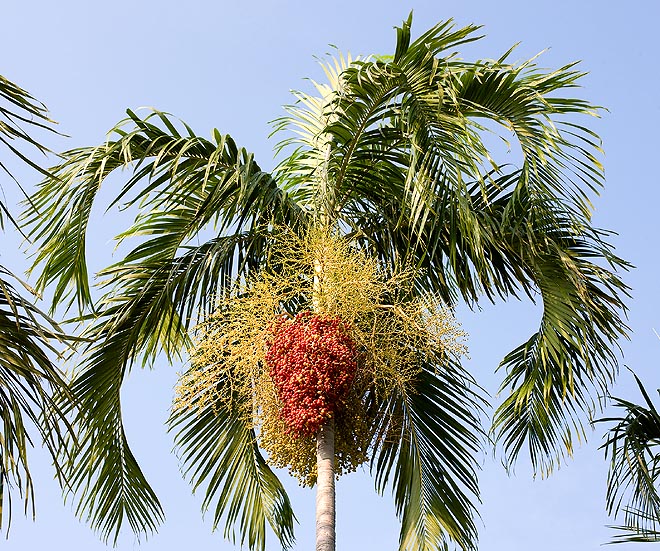Family : Arecaceae

Text © Pietro Puccio

English translation by Mario Beltramini

Chic and ornamental, the Carpentaria acuminata may be 20 m tall with 3,5 m leaves © Giuseppe Mazza
The name of the gnus refers to the Gulf of Carpentaria, close to its place of origin; the name of the species is the Latin word “acuminatus, a, um = sharp, pointed, with unsure reference, maybe to the sharp apex of its fruits.
Common names: Carpentaria palm, Darwin palm (English); palmier Car- pentaria, palmier de Darwin (French); Carpentaria, palmeira Carpentaria (Portuguese); palma Carpentaria (Spa- nish); Carpentaria Palme (German).
The Carpentaria acuminata (H. Wendl. & Drude) Becc. (1885) is a monoecious plant, with single stem, slender, smooth, up to 20 m tall with a diameter of about 20 cm, slightly ampler at the base, of pale grey colour with the the prominent rings trace of the junction of the fallen leaves.
The leaves are pinnate, elegantly curved, up to about 3,5 m long, on a 30 cm long petiole covered by tiny brown scales. The pinnulae, inserted on the rachis with an angle slightly pointing upward, are of glossy dark green colour on the upper side, bluish green, under, 20-60 cm long and 2-4 cm broad, with the extremity obliquely truncated, indented and hanging; the lower pinnulae are much wider, pleated and more serrated than the median ones, whilst the terminal ones are united at the base in the shape of a fish tail.
The foliar base, of an intense green colour, wraps completely the stem for a length of 0,8-1,3 m. The inflorescences come out under the leaves, are ramified and almost hanging, up to 1,5 m long with cream white coloured flowers placed in the typical triad (one female flower between two male flowers), but at the apex where are present only male flowers.
Usually, in the same time, are present several inflorescences in different stages of development. The fruits are ovoid or globular with sharp apex, of scarlet colour when ripe, 1-2 cm long, containing one seed only; the pulp is much irritant due to the presence of crystal of calcium oxalate, they are therefore to be handled with attention, possibly wearing gloves.
The seeds which must be fresh as having a limited duration of germination, do germinate in 1-3 months at the temperature of 26-28 °C, the times get longer at lower temperatures; in the humid-warm climates, it is one of the fastest growing palms and may reach, in the optimal conditions of cultivation, the reproductive age in six, seven years.
Plant of very high ornamental and landscape value, it is suitable to the tropical and humid subtropical climates, its cultivation may be tried in the temperate climate zones in particularly favourable microclimatic niches, in fact, it may bear sporadic temperatures, and for very short time, just under the 0 °C. It is not particular about the type of soil, provided the same is well drained and regularly and abundantly watered, especially in the dry periods; the best exposition is that in full sun, except the first 2-3 years when it is kept in partially shaded position. In pot, in groups of three, it has a moderate utilization in the decoration of luminous interiors, utilizing a mould rich of organic substance with addition of agri-perlite, or other inert product for improving the drainage, in the measure of the 30%.
Synonyms: Kentia acuminata H.Wendl. & Drude (1875).
→ For general notions about ARECACEAE please click here.
